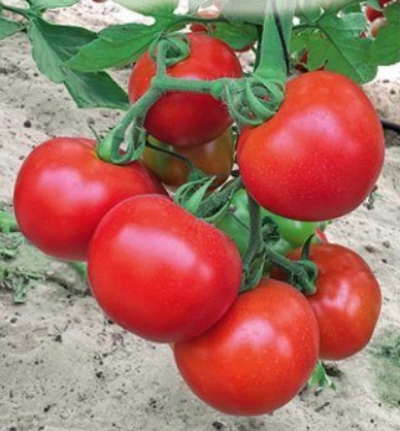
- Authors: Boaz Kaplan (NIRIT SIDZ LTD)
- Year of approval: 2013
- Category: hybrid
- Growth type: indeterminate
- Appointment: fresh consumption
- Ripening period: early
- Ripening time, days: 85-90
- Growing conditions: for closed ground
- Marketability: excellent
- Transportability: good
Growing delicious tomatoes is the dream of every gardener and owner of a small greenhouse. Early ripe varieties are in high demand, which give tasty and aromatic tomatoes. One of these is the hybrid type of Kochava tomato.
Breeding history
The hybrid Kokhava tomato is the result of many years of work by a group of Russian and Israeli breeders. The culture was bred in 2010. The hybrid was introduced to Rosreestr and approved for cultivation in 2013. Scientists have created early-maturing, highly immune tomatoes that grow in indoor greenhouses.
Description of the variety
The Kohava plant is a tall shrub with an indeterminate type of growth. The plant stretches in height up to 180-300 cm. The culture is characterized by compactness, despite its growth, high thickening of the foliage of a dark green color, a strong central stem, flexible branches. It has a powerful root system, the type of inflorescence is simple.
The first inflorescence is formed over 7-9 leaves. Up to 5-6 ovaries (berries) are formed in one fruit cluster. Cultivation of a culture involves the formation of bushes in 1-2 stems, the obligatory garter to strong supports or trellises, as well as partial removal of stepsons.
The main qualities of the fruit
Kohava tomato is a bright representative of large-fruited tomatoes, gaining weight up to 105-111 grams. Sometimes tomatoes grow up to 150 g. The shape of the berries is flat-round with a barely pronounced ribbing of the surface. In the stage of full maturity, the tomato acquires a deep pink color, and in the unripe form, it becomes light green.
The Kohava variety is universal, so tomatoes are eaten fresh, canned, processed, and also suitable for pickling. The tomato skin is moderately firm, firm, with a perfectly smooth surface. The peel prevents the appearance of cracks, and also ensures the transportability of the fruits, their long-term keeping quality.
Taste characteristics
The berries have a classic taste - sweet and sour, with a pronounced spicy aroma. The pulp does not contain a white core. In structure, the pulp is dense, fleshy, juicy, but not watery, with a small number of seeds.
Ripening and fruiting
The Kohava variety is early maturing. From germination of seeds to ripe berries on the bushes, it takes 3 months (85-90 days). Fruiting is extended, so you can eat fresh tomatoes from the garden until autumn.
Yield
The culture is considered to be high yielding. Carrying out all the care measures, up to 30 kg of tomatoes are harvested from 1 m2.
The timing of planting seedlings and planting in the ground
The culture is planted by seedling method. Seeds are sown 55-60 days before transfer to a greenhouse or garden bed. After sowing, it is recommended to accelerate the germination of the sprouts by covering the seeds with plastic or glass. At the stage of appearance of 2-3 leaves, a dive is carried out, that is, the healthiest plants are planted in separate pots.
In order for the seedlings to quickly adapt to new growing conditions, it must be hardened.10-12 days before transplanting to the greenhouse, you need to take out the seedlings to fresh air every day.
In open ground, planting of seedlings is carried out with stably heated air and soil. The necessary conditions for growth must also be observed in the greenhouse.

Growing tomato seedlings is an extremely important process, because it largely depends on whether the gardener will be able to harvest at all. All aspects must be taken into account, from seedbed preparation to planting in the ground.
Landing scheme
In order for the plant to feel comfortable and bear fruit well, it is necessary to observe the density and planting pattern. The planting density of 5 bushes per 2 m2 is considered optimal for planting. The best scheme is considered to be 40x70 cm.

Growing and care
Kochava tomatoes love loose, fertilized, moisturized and breathable soil. The best for growing tomatoes is considered to be the area where pumpkin, zucchini, cabbage and carrots were the predecessors. Kohava tomatoes, like other nightshade crops, require care - watering with warm water, applying fertilizers according to a certain pattern, loosening the soil, forming and tying bushes, protection from insects and viruses. And also this is the regular ventilation of greenhouses and the partial removal of stepsons.




A plant needs different micronutrients at each stage of growth. All fertilizers can be divided into two groups: mineral and organic. Folk remedies are often used: iodine, yeast, bird droppings, eggshells.
It is important to observe the rate and period of feeding. This also applies to folk remedies and organic fertilizers.
Disease and pest resistance
Immunity is high. The hybrid is not afraid of many diseases - verticillosis, cladosporia, yellow twisting of leaves, fusarium wilting, VTB, as well as late blight. From invasions of pests, they are treated with a solution of potassium permanganate.


Resistant to adverse weather conditions
The hybrid variety has excellent stress resistance, therefore it perfectly forms ovaries during sharp temperature fluctuations. In addition, the plant tolerates drought, extreme heat and partial shade.
Growing regions
The Central region is considered optimal for cultivation, however, in greenhouse conditions, tomatoes grow and bear fruit in colder climatic zones. Tomatoes grow on the beds in the southern strip.

























































































